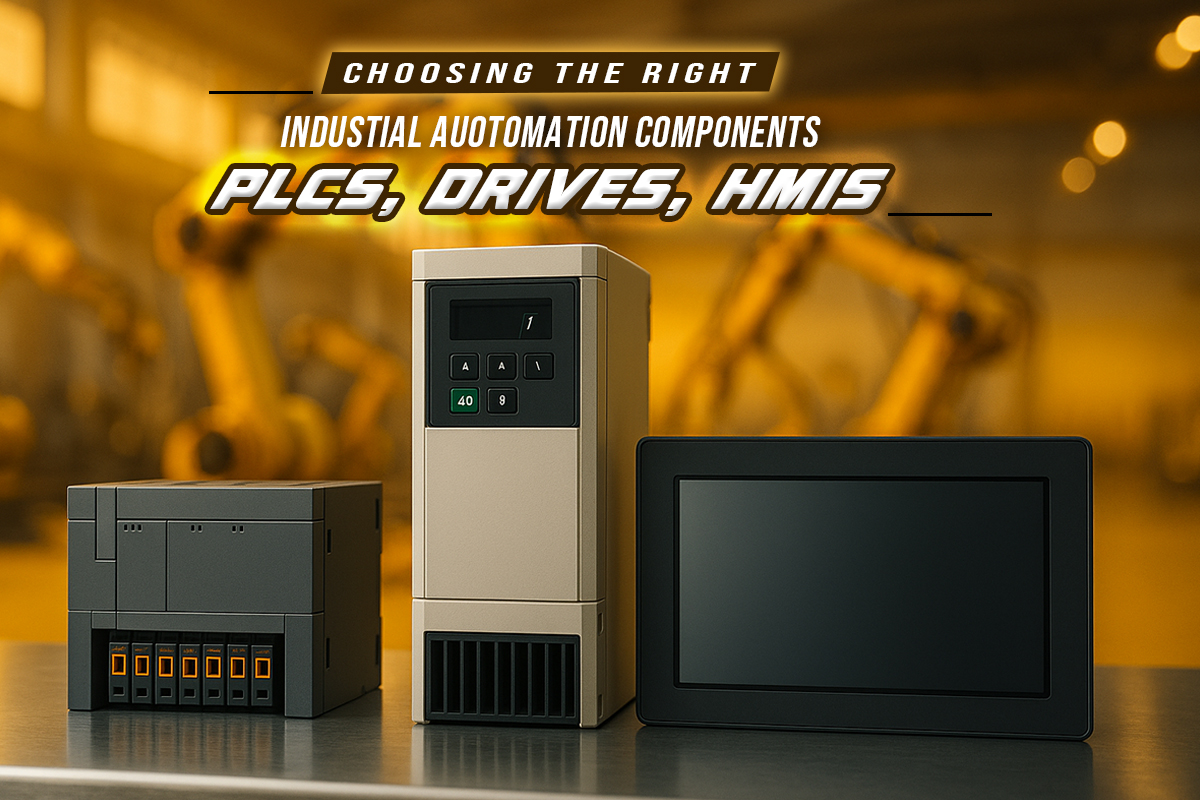Why Choosing the Right Automation Component Matters
Automation components are like the brain, muscles, and senses of your industrial setup.
-
PLCs are the brain—they process data and make real-time decisions.
-
Drives are the muscles—they control the speed, torque, and performance of motors.
-
HMIs are the senses—they give operators a window into the system and allow control with ease.
The wrong choice can lead to frequent breakdowns, higher energy bills, complicated maintenance, or poor scalability. The right choice ensures smooth operations, cost savings, and future-ready performance.
Step 1: Understanding PLCs – The Brain of Automation
A Programmable Logic Controller (PLC) is the control unit that monitors inputs, processes logic, and sends commands to output devices like motors, valves, or alarms.
What to Consider When Choosing a PLC:
-
Size of Your Operation
-
Small-scale machines → Compact PLCs
-
Large production lines → Modular PLCs
-
-
I/O (Input/Output) Requirements
-
How many sensors, switches, and actuators are connected?
-
Plan for expansion—choose slightly higher I/O capacity.
-
-
Communication Protocols
-
Modern PLCs support Ethernet, Modbus, Profibus, and other industrial protocols.
-
Ensure compatibility with your existing setup.
-
-
Processing Speed
-
High-speed processes (like packaging or robotics) need faster PLCs.
-
For basic applications (like pumps or lighting), standard speed is enough.
-
-
Environment & Durability
-
For marine or dusty factories → rugged PLCs with IP65/67 protection.
-
For clean industries (like food processing) → compact standard PLCs are fine.
-
Pro Tip: Always check the brand’s global service support, as downtime costs money.
Step 2: Choosing Drives – The Muscles of Automation
Drives control the speed, direction, and torque of motors—making them essential for energy efficiency and precise control.
Types of Drives:
-
VFDs (Variable Frequency Drives)
-
Best for pumps, fans, and conveyors.
-
Save energy by adjusting motor speed.
-
-
Servo Drives
-
Best for robotics, CNC machines, and packaging lines.
-
Offer high precision and fast response.
-
Key Factors to Consider:
-
Motor Compatibility → Always match drive rating with motor rating.
-
Load Type
-
Constant torque loads (like compressors) need heavy-duty drives.
-
Variable torque loads (like fans) can use energy-efficient drives.
-
-
Control Features
-
Look for drives with vector control, regenerative braking, and safety features.
-
-
Energy Efficiency
-
Drives can reduce electricity costs by 20–50%.
-
-
Scalability
-
If you plan future expansions, invest in drives that support networking with PLCs and HMIs.
-
Step 3: Selecting HMIs – The Eyes and Hands of Automation
A Human Machine Interface (HMI) makes it easier for operators to monitor, control, and troubleshoot machines.
What to Look for in an HMI:
-
Screen Size & Resolution
-
Small machines → 4″–7″ HMIs are enough.
-
Large production → 10″–15″ or multi-screen setups work better.
-
-
User Interface (UI)
-
Touchscreen with easy navigation.
-
Customizable layouts for different operators.
-
-
Connectivity
-
Ensure it supports Ethernet, USB, and fieldbus connections.
-
Cloud-ready HMIs are a bonus for remote monitoring.
-
-
Durability
-
Industrial HMIs should withstand dust, vibration, and temperature changes.
-
Marine HMIs often need waterproofing.
-
-
Advanced Features
-
Alarms, data logging, trend analysis, and remote monitoring.
-
Pro Tip: Don’t overspend on oversized HMIs unless necessary—match the interface with your team’s needs.
Step 4: Integration – Making PLCs, Drives, and HMIs Work Together
Even the best components can underperform if they don’t integrate well.
-
Choose components that speak the same communication language (Ethernet/IP, Modbus, Profinet, etc.).
-
Prefer solutions from the same brand family (like Siemens, Allen-Bradley, Mitsubishi, or Omron) for easier compatibility.
-
If mixing brands, ensure you have reliable gateway modules.
-
Test on a small scale before full deployment.
Step 5: Future-Proofing Your Investment
Technology keeps evolving. To avoid expensive upgrades:
-
Pick modular PLCs for easy expansion.
-
Choose drives that support IoT and predictive maintenance.
-
Invest in HMIs with cloud and mobile app connectivity.
-
Ensure your system supports remote diagnostics—saving travel costs and downtime.
Common Mistakes to Avoid
-
Over-specifying → Buying more advanced equipment than needed, leading to wasted money.
-
Under-specifying → Choosing cheaper options that fail under load.
-
Ignoring Environment → Not considering dust, temperature, or humidity.
-
Neglecting After-Sales Support → Always check service availability in your region.

